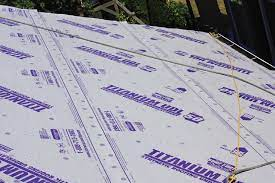Your roof is more than just shingles or tiles; it's a complex system designed to protect your home from the elements. At the heart of this system lies roof underlayment, an often-underappreciated component that provides an additional layer of defense. Different types of underlayment offer varying levels of protection and performance. In this post, brought to you by Malick Brothers Exteriors, we'll explore five types of roof underlayment to help you understand their unique features and benefits.
1. Asphalt-Saturated Felt Underlayment:
Asphalt-saturated felt, also known as felt paper, is one of the most traditional and widely used underlayment materials. It consists of a base material saturated with asphalt to enhance water resistance. This type of underlayment is cost-effective and can provide an additional layer of protection during the roofing installation process.
2. Synthetic Underlayment:
Synthetic underlayment is a modern and advanced alternative to traditional felt paper. It is typically made from polypropylene or polyethylene and offers superior durability and weather resistance. Synthetic underlayment is lightweight, easy to handle, and provides enhanced protection against moisture.
3. Rubberized Asphalt Underlayment:
Rubberized asphalt underlayment is known for its exceptional waterproofing capabilities. It contains a layer of rubberized asphalt, which makes it an excellent choice for areas prone to heavy rain or where ice and water shield protection is required. This type of underlayment is highly effective in preventing leaks.
4. Peel-and-Stick Underlayment:
Peel-and-stick underlayment, also known as self-adhering underlayment, is a convenient and user-friendly option. It features a sticky backing that adheres directly to the roof deck, eliminating the need for fasteners. This type of underlayment is ideal for low-slope roofs and provides excellent protection against water infiltration.
5. Fiberglass-Reinforced Underlayment:
Fiberglass-reinforced underlayment combines the benefits of both fiberglass and asphalt to create a strong and durable option. It offers resistance to tearing and punctures, making it suitable for roofs with high wind exposure and potential damage from falling debris.
Selecting the Right Underlayment:
Choosing the appropriate underlayment depends on factors such as your local climate, the type of roofing material you plan to install, and your budget. Each type of underlayment has its advantages and is best suited to specific roofing situations.
– For traditional roofing projects, asphalt-saturated felt may suffice.
– In areas with heavy rainfall or snow, rubberized asphalt underlayment can be a valuable addition.
– In regions with strong winds or for modern roofing materials like metal or tile, fiberglass-reinforced underlayment might be the best choice.
Malick Brothers Exteriors can provide expert guidance on selecting the right underlayment for your roofing project. Whether you're installing a new roof or considering a roof replacement, choosing the appropriate underlayment is essential to ensure your home's protection and longevity.

